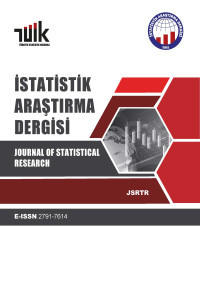Uzunlamasına Kesikli Veriler için Regresyon Modellerinin SAS ile Uygulanması
Bu çalışmada, öncelikle, uzunlamasına kesikli veri için marjinal model ve genelleştirilmiş lineer karma model sınıflarını ele alacağız ve sonra marjinal ve genelleştirilmiş lineer karma modellerinin özelliklerini birleştiren, Log-Log-Gamma marjinalleştirilmiş çok seviyeli modellerini yeniden gözden geçireceğiz. Bu modellerin bilgisayar ortamına aktarılması onların sahip olduğu birtakım özelliklerden dolayı, dikkat gerektirmektedir. Bu nedenden dolayı, bu durum marjinal modeller için SAS GENMOD, GLMM için SAS GLIMMIX ve Log-Log-Gamma marjinalleştirilmiş çok seviyeli modelleri için de SAS NLMIXED prosedürünü kullanmamıza öncülük etmektedir. Son model, gamma dağılımlı rassal etkiler içerdiğinden, ilk olarak Gamma Frailty modelleri için kullanılmış olan iki farklı yöntem, isim vermek gerekirse, olasılık integral dönüşümü ve olabilirlik yeniden formülasyonu yöntemleri değiştirilerek, Log-Log-Gamma marjinalleştirilmiş çok seviyeli modelleri için PROC NLMIXED prosedürü çerçevesinde uyarlanmıştır. Son olarak, çalışmamızı bu modellerin popüler epilepsi nöbet sayısı verisine uygulanmasından elde edilen sonuçları tartışarak bitirmekteyiz.
Anahtar Kelimeler:
Epilepsi nöbet sayısı, Gamma dağılımlı rassal etkiler, SAS GENMOD, SAS GLIMMIX, SAS NLMIXED
Implementation of Regression Models for Longitudinal Count Data Through SAS
In this study, we firstly consider the marginal model and generalized linear mixed model classes for longitudinal count data and review the Log-Log-Gamma marginalized multilevel model, which combines the features of marginal models and generalized linear mixed models. Due to the special features of these models, implementation of them requires more special attention. As a consequence, this leads us to use SAS GENMOD procedure for the marginal model, SAS GLIMMIX procedure for the GLMM, and SAS NLMIXED procedure for the Log-Log-Gamma marginalized multilevel model. Since the latter model requires gamma distributed random effects, two different techniques, namely the probability integral transformation technique and likelihood reformulation technique , which are originally used for fitting Gamma Frailty models, are modified and adapted to fit Log-Log- Gamma marginalized multilevel model within the framework of Proc NLMIXED. Finally, we conclude the study with the discussion of the results obtained from the implementation of the models through popular epileptic seizures data.
Keywords:
Epileptic seizure count, Gamma random effects, SAS GENMOD, SAS GLIMMIX, SAS NLMIXED,
___
- Abramowitz, M., Stegun, I., 1972. Handbook of Mathematical Functions. Dover, New York.
- Barron, D. N., 1992. The Analysis of count data: Overdispersion and Autocorrelation. Sociological Methodology, 22:179-220.
- Cameron, A. C., Trivedi, P. K., 1998. Regression Analysis of Count Data. Econometric Society Monographs. Cambridge University Press, New York.
- Diggle, P. J., Heagerty, P., Liang, K. Y., Zeger, S., 2002. Analysis of Longitudinal Data. Oxford University Press.
- Fitzmaurice, G., Molenberghs, G., 2008. Advances in longitudinal data analysis: A historical perspective, in Longitudinal Data Analysis: A Handbook of Modern Statistical Methods, eds. G. Fitzmaurice, M. Davidian, G. Molenberghs, G. Verbeke, pp 3-27. Boca Raton, FL: Chapman & Hall/CRC Press, Florida.
- Flom, P. L., McMahon, J. M., Pouget, E. R., 2006. Using PROC NLMIXED and PROC GLMMIX to analyze dyadic data with binary outcomes.Northeast SAS Users Group (NESUG) Proceedings, SAS Inc., Cary, NC.
- Greenwood, M., Yule, G.U., 1920. An Inquiry into the Nature of Frequency Distributions Representative of Multiple Happenings with Particular Reference to the Occurrence of Multiple Attacks of Disease or of Repeated Accidents. Journal of the Royal Statistical Society, 83:255-279.
- Griswold, M. E., Zeger, S. L., 2004. On Marginalized Multilevel Models and their Computation. The Johns Hopkins University, Department of Biostatistics Working Papers.
- Heagerty, P. J., Zeger, S. L. 2000. Marginalized multilevel models and likelihood inference. Statistical Science, 15(1):1-26.
- Jowaheer, V., Sutradhar, B. C., 2002. Analyzing longitudinal count data with overdispersion. Biometrika, 89(2):389-399.
- Leppik, I. E., Dreifuss, F. E., Bowman-Cloyd, T., Santilli, N., Jacobs, M., Crosby, C., Cloyd, J., Stockman, J., Graves, N., Sutula, T., Welty, T., Vickery, J., Brundage, R., Gumnit, R., Gutierres, A., 1985. A double-blind crossover evaluation of progabide in partial seizures. Neurology, 35:285.
- Liang, K. Y., Zeger, S. L., 1986. Longitudinal data analysis using generalized linear models. Biometrika, 73:13-22.
- Lipsitz, S., Fitzmaurice, G., 2008. Generalized estimating equations for longitudinal data analysis. In Longitudinal Data Analysis: A Handbook of Modern Statistical Methods, eds. G. Fitzmaurice, M. Davidian, G. Molenberghs, G. Verbeke, pp 43-78. Boca Raton, FL: Chapman & Hall/CRC Press, Florida.
- Liu, L., Yu, Z., 2008. A likelihood reformulation method in non-normal random effects models. Statistics in medicine, 27:3105-3124.
- Molenberghs, G.,Verbeke, G., 2005. Models for Discrete Longitudinal Data. Springer, New York.
- Nelson, K. P., Lipsitz, S. R., Fitzmaurice, G. M., Ibrahim, J., Parzen, M., Strawderman, R., 2006. Use of the Probability Integral Transformation to Fit Nonlinear Mixed-Effects Models With Nonnormal Random Effects. Journal of Computational & Graphical Statistics, 15(1):39-57.
- SAS/STAT User’s Guide, Version 8, Chapter 46 (SAS Institute Inc.,Cary, NC, 2000).
- Venables, W. N., Ripley, B. D. 2002. Modern Applied Statistics with S. Fourth Edition. Springer, New York.
- Weiss, R. E., 2005. Modeling longitudinal data. Springer, New York.
- ISSN: 1303-6319
- Başlangıç: 2002
- Yayıncı: TÜİK
